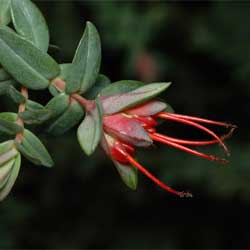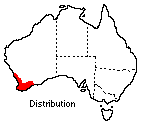Darwinia citriodora
 |
 |
Lemon-scented Darwinia
Darwinia citriodora (Endl.) Benth.
Darwinia citriodora is one of more than twenty species of Darwinia from Western Australia and occurs in the Darling, Warren and Stirling districts of the south-west province, from the Swan River to King George's Sound, and eastward to Cape Riche, a region of essentially winter rainfall. About seven species of Darwinia, a member of the Myrtaceae family, also occur in the eastern States and South Australia.
 It
grows to a height of between 1 m and 1.5 m with a similar spread, forming a
compact rounded shrub. The leaves are most attractive, colouring during winter
with traces of purple-red which accentuate the venation of newer leaves. They
are usually rich green, 6 mm to 12 mm long , varying from oblong to almost lanceolate
with blunt ends and curved back margins; they are arranged nearly opposite in
pairs along the stems. The underside of the leaves is distinctively marked with
numerous oil glands and when crushing stems or leaves between the fingers a
pleasant lemon scent is given off. This scent gives rise to the common name,
Lemon-scented Myrtle.
It
grows to a height of between 1 m and 1.5 m with a similar spread, forming a
compact rounded shrub. The leaves are most attractive, colouring during winter
with traces of purple-red which accentuate the venation of newer leaves. They
are usually rich green, 6 mm to 12 mm long , varying from oblong to almost lanceolate
with blunt ends and curved back margins; they are arranged nearly opposite in
pairs along the stems. The underside of the leaves is distinctively marked with
numerous oil glands and when crushing stems or leaves between the fingers a
pleasant lemon scent is given off. This scent gives rise to the common name,
Lemon-scented Myrtle.
In Canberra D. citriodora flowers from July to January or even longer. The flowers are borne in slightly pendulous terminal clusters of four, or sometimes five or six, each with a prominent style about 1 cm long and curved at the tip towards the centre of the cluster. As the styles mature a change in colour may occur from yellow with red stigmas to orange-red. The corolla segments are small and yellow with a tinge of red and enclose the ten short stamens which bear globular anthers. The corolla is in turn enclosed by eight red-green, leaf-like bracts. It is these prominent bracts and long protruding styles which give character to the flowers.
It adapts reasonably well to Canberra's soil and climatic conditions although protection from frost is advisable, especially while the plant is young; adequate summer water is necessary. A warm position in semi-shade will suit, but if it is too heavily shaded pruning may become necessary because the resultant growth may be elongated and sparse. Normally no pruning is needed apart from an occasional 'tipping' of shoots following flowering. The normal practice of applying a general fertilizer in early spring will produce good results as will well-rotted animal manures lightly worked into the soil around the plant's root zone. A mulch of leaves, bark, rotted grass clippings or similar material applied after spring fertilising will conserve soil moisture during summer. The plant seems to be free of serious disease and insect pests.
Propagation is quite easy from firm tip-cuttings taken at any time, though best results are obtained at the end of summer or early autumn. Rooting hormone, though not essential, can be applied to the base of the cuttings before they are placed in the propagating medium. Regular applications of liquid fertilizer are beneficial after cuttings have rooted.
Darwinia citriodora is perhaps best used as a foliage plant in groups of three or more. Its winter colouring, attractive lemon-scented foliage and the fact that it is virtually pest-free make it an ideal plant for this purpose.
Text by ANBG staff (1978)
Name meaning: Darwinia citriodoraDarwinia - after Dr Erasmus Darwin (1731-1802), the grandfather of the famous evolutionist, Charles Darwin; citriodora - of Greek origin and meaning lemon-scented |
![An Australian Government Initiative [logo]](/images/austgovt_brown_90px.gif)

